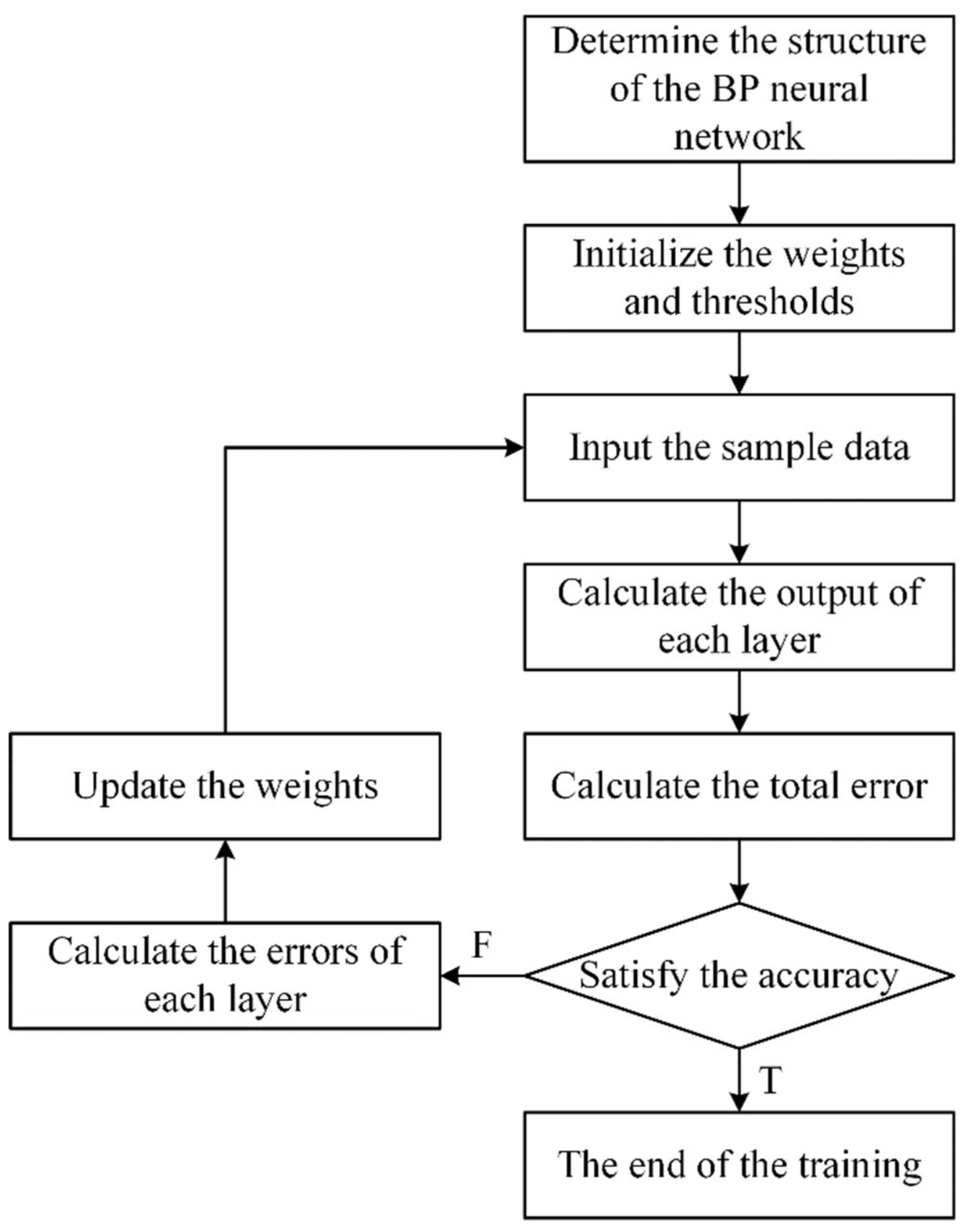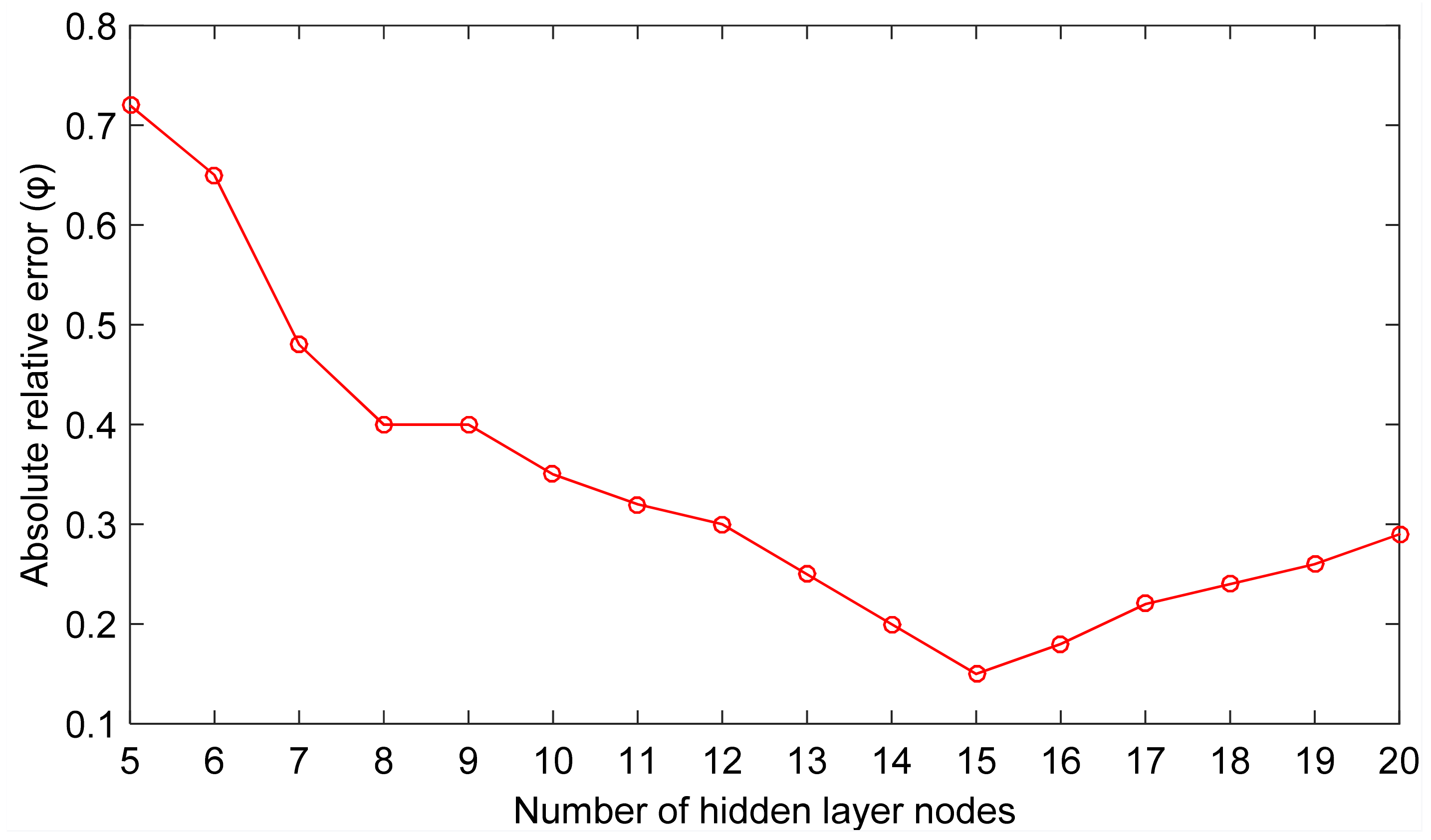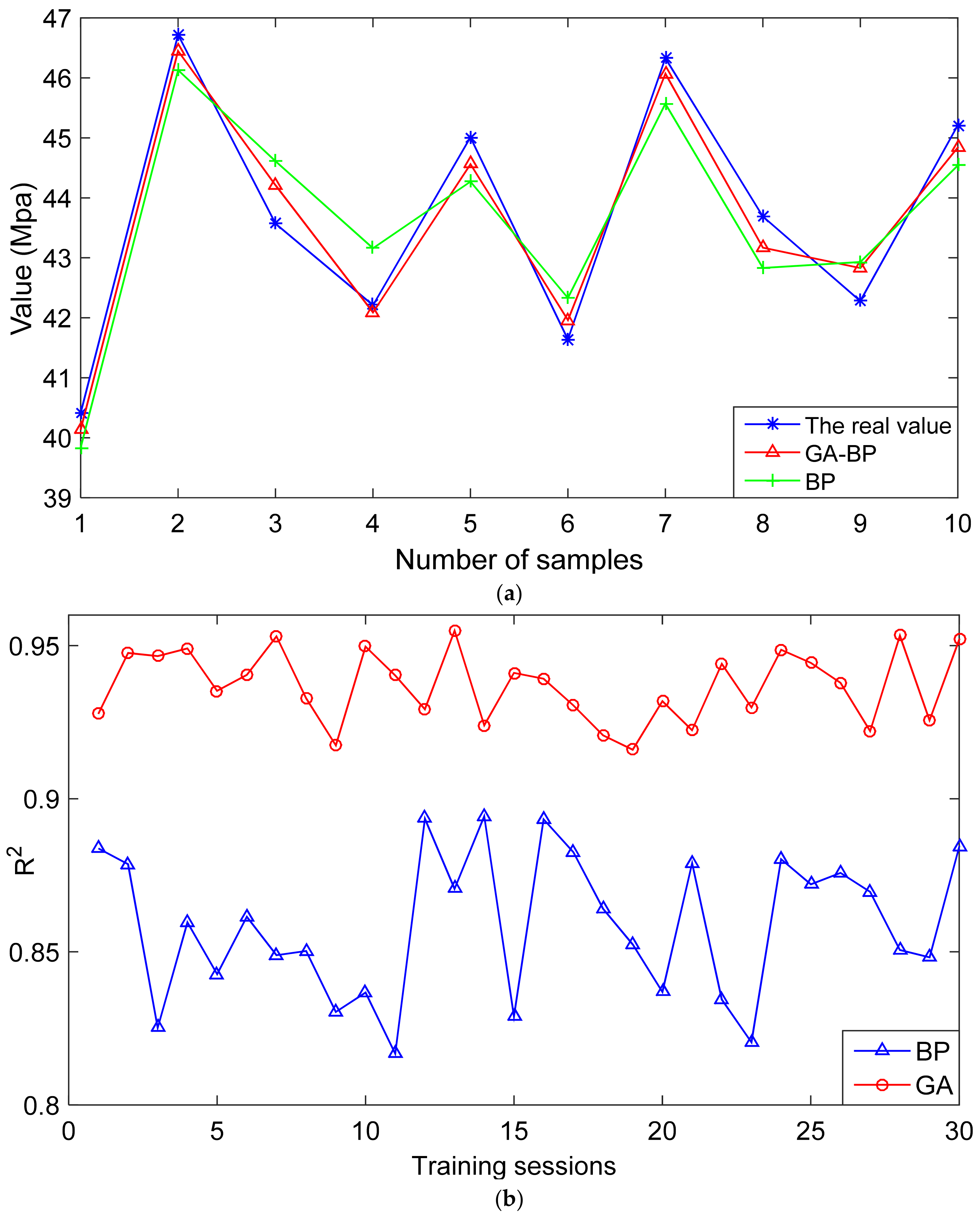Prediction of the First Weighting from the Working Face Roof in a Coal Mine Based on a GA-BP Neural Network
Abstract
1. Introduction
2. The BP Neural Network Model
2.1. Fundamentals of the BP Neural Network
2.2. Selection of the Sample Data
2.3. Model Parameters
- (1)
- The number of hidden layers
- (2)
- The number of hidden layer neurons
- (3)
- The initial weights
- (4)
- The activation function
- (5)
- The learning rate
- (6)
- The expected error
2.4. Training Results of the BP Model
- (1)
- The first roof weighting strength
- (2)
- Predicting the first roof weighting interval
3. BP Prediction Model of First Weighting Based on the Genetic Algorithm (GA)
- (1)
- Population initialization
- (2)
- Fitness function
- (3)
- Operator selection
- (4)
- Crossover operator
- (5)
- Mutation operator
4. Results and Discussion
4.1. Comparison of the First Roof Weighting Strength
4.2. Comparison of the First Roof Weighting Interval
5. Conclusions
- A lot of influencing factors can be determined in the course of prediction of the first weighting of the working face roof utilizing artificial neural network methods, which can map the complicated nonlinear relation between them.
- The gray correlation degree is used to calculate the relational degrees between the first weighting of the working face roof and various influencing factors in the Datong mining area. The input parameters of the BP prediction model include the width of the working face, mining height, advance speed, roof condition of the coal seam, burial depth, thickness and dip of the coal seam, change rate of the inclination angle, burial depth, coal thickness, direct top thickness, and thickness of the main roof.
- Compared with traditional BP, the BP-GA model has stronger robustness, is available for parallel global searching, and can improve the accuracy of prediction results and the stability of the prediction model.
- We can extend this method of calculating the initial compression strength and step distance to other mining areas. As long as we can collect enough input parameter data, we can train a prediction model that is suitable for each mining area.
Author Contributions
Funding
Conflicts of Interest
References
- Yuan, X. The Characters andTrend of Accidents in the Coal Mining in China. Dis. Adv. 2012, 5, 866–869. [Google Scholar]
- Duzgun, H.S.B.; Einstein, H.H. Assessment and management of roof fall risks in underground coal mines. Saf. Sci. 2004, 42, 23–41. [Google Scholar] [CrossRef]
- Palei, S.K.; Das, S.K. Logistic regression model for prediction of roof fall risks in bord and pillar workings in coal mines: An approach. Saf. Sci. 2009, 47, 88–96. [Google Scholar] [CrossRef]
- Razani, M.; Yazdani-Chamzini, A.; Yakhchali, S.H. A novel fuzzy inference system for predicting roof fall rate in underground coal mines. Saf. Sci. 2013, 55, 26–33. [Google Scholar] [CrossRef]
- Maiti, J.; Khanzode, V.V. Development of a relative risk model for roof and side fall fatal accidents in underground coal mines in India. Saf. Sci. 2009, 47, 1068–1076. [Google Scholar] [CrossRef]
- Qian, M.G.; Shi, P.W. Mining Pressure and Strata Control; Xu, J.L., Ed.; China University of Mining and Technology Press: Xuzhou, China, 2010; pp. 100–119. [Google Scholar]
- Khandelwal, M.; Kumar, D.L.; Yellishetty, M. Application of soft computing to predict blast-induced ground vibration. Eng. Comput. 2011, 27, 117–125. [Google Scholar] [CrossRef]
- Khandelwal, M.; Singh, T.N. Prediction of blast-induced ground vibration using artificial neural network. Int. J. Rock Mech. Min. Sci. 2009, 46, 1214–1222. [Google Scholar] [CrossRef]
- Monjezi, M.; Ahmadi, Z.; Varjani, A.Y.; Khandelwal, M. Backbreak prediction in the Chadormalu iron mine using artificial neural network. Neural Comput. Appl. 2013, 23, 1101–1107. [Google Scholar] [CrossRef]
- Zhang, H.; Song, J.; Su, C.; He, M. Human attitudes in environmental management: Fuzzy Cognitive Maps and policy option simulations analysis for a coal-mine ecosystem in China. J. Environ. Manag. 2013, 115, 227–234. [Google Scholar] [CrossRef]
- Zhang, R.; Lowndes, I.S. The application of a coupled artificial neural network and fault tree analysis model to predict coal and gas outbursts. Int. J. Coal Geol. 2010, 84, 141–152. [Google Scholar]
- Mohammed, M.; Watanabe, K.; Takeuchi, S. Grey model for prediction of pore pressure change. Environ. Earth Sci. 2010, 60, 1523–1534. [Google Scholar] [CrossRef]
- Doostmohammadi, R.; Moosavi, M.; Araabi, B.N. A model for determining the cyclic swell-shrink behavior of argillaceous rock. Appl. Clay Sci. 2008, 42, 81–89. [Google Scholar] [CrossRef]
- Ambrozic, T.; Turk, G. Prediction of subsidence due to underground mining by artificial neural networks. Comput. Geosci. 2003, 29, 627–637. [Google Scholar] [CrossRef]
- Ashena, R.; Moghadasi, J. Bottom hole pressure estimation using evolved neural networks by real coded ant colony optimization and genetic algorithm. J. Pet. Sci. Eng. 2011, 77, 375–385. [Google Scholar] [CrossRef]
- Winiczenko, R.; Górnicki, K.; Kaleta, A.; Mańkowska-Janaszek, M. Optimisation of ANN topology for predicting the rehydrated apple cubes colour change using RSM and GA. Neural Comput. Appl. 2018, 30, 1795–1809. [Google Scholar] [CrossRef] [PubMed]
- Bashir, Z.A.; El-Hawary, M.E. Applying wavelets to short-term load forecasting using PSO-based neural networks. IEEE Trans. Power Syst. 2009, 24, 20–27. [Google Scholar] [CrossRef]
- Liu, K.; Guo, W.; Shen, X.; Tan, Z. Research on the forecast model of electricity power industry loan based on GA-BP neural network. Energy Procedia 2012, 14, 1918–1924. [Google Scholar]
- Bahadir, E. Prediction of prospective mathematics teachers’ academic success in entering graduate education by using back-propagation neural network. J. Educ. Train. Stud. 2016, 4, 113–122. [Google Scholar] [CrossRef]
- He, Y.; Li, X.L.; Shao, Y.N. Discrimination of varieties of apple using near infrared spectra based on principal component analysis and artificial neural network model. Spectrosc. Spectr. Anal. 2006, 26, 850–853. [Google Scholar]
- Cao, J.C.; Cao, S.H. Study of forecasting solar irradiance using neural networks with preprocessing sample data by wavelet analysis. Energy 2006, 31, 3435–3445. [Google Scholar] [CrossRef]
- Gu, S.; Yao, B. Study on strata behavior regularity of 1301 face in thick bedrock of Wei—Qiang coal mine. In IOP Conference Series: Materials Science and Engineering; IOP Publishing: Bristol, UK, 2017; Volume 231, p. 12108. [Google Scholar]
- Li, J.; Huang, Y.; Zhang, J.; Li, M.; Qiao, M.; Wang, F. The influences of Key Strata compound breakage on the overlying strata movement and strata pressure behavior in fully mechanized caving mining of shallow and extremely thick seams: A case study. Adv. Civil Eng. 2019, 2019, 1–11. [Google Scholar] [CrossRef]
- Lin, G.-Q.; Song, E.-B. The measurement of underground pressure regulation in Ulan Moron coal mine. In 2014 International Conference on Mechanics and Civil Engineering (icmce-14); Atlantis Press: Paris, France, 2014; Volume 7, pp. 287–291. [Google Scholar]
- Zhao, J.; Liu, L.; Zheng, Z. Law of strata pressure behavior in shallow coal seam. In IOP Conference Series: Earth and Environmental Science; IOP Publishing: Bristol, UK, 2018; Volume 113. [Google Scholar]
- Zhu, B.; Li, G.; Kou, W.; Li, H. Simulation of strata behaviour laws of a coal mine in Jungar Coalfield. In Proceedings of the 3rd International Symposium on Mine Safety Science and Engineering, Montreal, Canada; 2016; pp. 651–654. [Google Scholar]
- Liu, S.F.; Xie, N.M. Grey System Theory and Application; Science Press: Beijing, China, 2010; pp. 42–132. [Google Scholar]
- Yang, B.; He, L.B. Establishment and analysis of two normalization methods for backscattering intensity data. Acta Oceanol. Sin. 2018, 40, 145–151. [Google Scholar]
- Gocic, M.; Motamedi, S.; Shamshirband, S.; Petkovic, D.; Sudheer, C.; Hashim, R.; Arif, M. Soft computing approaches for forecasting reference evapotranspiration. Comput. Electron. Agric. 2015, 113, 164–173. [Google Scholar] [CrossRef]
- Whitley, D. A genetic algorithm tutorial. Stat. Comput. 1994, 4, 65–85. [Google Scholar] [CrossRef]
- Leung, Y.W.; Wang, Y.P. An orthogonal genetic algorithm with quantization for global numerical optimization. IEEE Trans. Evol. Comput. 2001, 5, 41–53. [Google Scholar] [CrossRef]
- Liu, C. Price forecast for gold futures based on GA-BP neural network. In Proceedings of the 2009 International Conference on Management and Service Science, Wuhan, China, 20–22 September 2009; pp. 1–4. [Google Scholar]
- Tahmasebi, P.; Hezarkhani, A. A hybrid neural networks-fuzzy logic-genetic algorithm for grade estimation. Comput. Geosci. 2012, 42, 18–27. [Google Scholar] [CrossRef] [PubMed]







| Buried Depth (m) | Change Rate of Buried Depth | Coal Seam Pitch (°) | Change Rate of Coal Seam Pitch | Working Face Width (m) | Thickness of Immediate Roof (m) | Thickness of Main Roof (m) | Mining Height (m) | Coal Thickness (m) | Change Rate of Coal Thickness | Advance Speed (m/d) | Roof Condition of Coal Seam | First Weighting Strength (MPa) | First Weighting Interval (m) |
|---|---|---|---|---|---|---|---|---|---|---|---|---|---|
| 225.18 | 0.119 | 1.4 | 0.615 | 184 | 12.35 | 23.08 | 4 | 4.1 | 0.4 | 5.8 | 3 | 46.9 | 59.8 |
| 155.71 | 0.303 | 2.7 | 0.6 | 253 | 8.08 | 17.35 | 3.4 | 3.4 | 0.15 | 10.5 | 2 | 46.0 | 45.1 |
| 190.83 | 0.046 | 6.6 | 0.35 | 295 | 4.09 | 30.00 | 4.1 | 4.3 | 0.98 | 7.0 | 1 | 35.9 | 46.6 |
| 217.87 | 0.081 | 1.0 | 0.67 | 267 | 6.20 | 20.60 | 3.5 | 3.7 | 0.27 | 9.2 | 2 | 42.4 | 49.1 |
| 244.73 | 0.055 | 7.5 | 0.875 | 205 | 4.84 | 14.29 | 3.6 | 3.5 | 0.34 | 11.8 | 3 | 39.2 | 43.3 |
| 254.30 | 0.556 | 6.1 | 0.5 | 228 | 6.37 | 34.89 | 4 | 4.0 | 0.17 | 8.0 | 2 | 42.7 | 54.3 |
| 196.61 | 0.469 | 4.3 | 0.3 | 240 | 8.28 | 20.04 | 4.2 | 4.2 | 0.22 | 9.9 | 2 | 40.4 | 49.2 |
| 139.41 | 0.353 | 5.0 | 0.8 | 308 | 9.33 | 25.83 | 4.4 | 4.5 | 0.75 | 10.3 | 3 | 40.6 | 59.7 |
| 140.90 | 0.4 | 2.5 | 1.5 | 200 | 8.49 | 32.95 | 2 | 2.0 | 0.08 | 8.0 | 3 | 36.9 | 49.2 |
| 156.05 | 0.66 | 4.1 | 0.8 | 291 | 13.50 | 23.42 | 4.3 | 4.2 | 0.23 | 9.6 | 2 | 38.1 | 53.2 |
| 237.70 | 0.182 | 7.7 | 0.8 | 264 | 9.22 | 34.35 | 3.4 | 3.5 | 0.18 | 5.8 | 1 | 34.3 | 59.8 |
| 155.60 | 0.46 | 4.7 | 0.33 | 229 | 14.32 | 24.45 | 4.5 | 4.5 | 0.41 | 11.5 | 2 | 48.8 | 45.1 |
| 234.00 | 0.28 | 4.6 | 1.25 | 205 | 10.65 | 32.82 | 3.3 | 3.3 | 0.13 | 6.3 | 2 | 44.5 | 46.6 |
| 154.09 | 0.294 | 2.5 | 0.22 | 236 | 14.49 | 33.42 | 3.1 | 3.2 | 0.45 | 6.9 | 3 | 48.9 | 49.1 |
| 250.10 | 0.079 | 4.3 | 0.8 | 243 | 5.89 | 25.83 | 3.9 | 4.0 | 0.63 | 10.6 | 1 | 36.6 | 43.3 |
| 169.00 | 0.31 | 5.3 | 0.8 | 196 | 11.11 | 13.57 | 2.5 | 2.6 | 0.04 | 8.4 | 2 | 48.7 | 54.3 |
| 147.52 | 0.23 | 5.7 | 0.157 | 257 | 6.47 | 22.59 | 3.1 | 3.2 | 0.13 | 10.4 | 2 | 46.7 | 49.2 |
| 155.15 | 0.063 | 3.6 | 0.72 | 209 | 11.06 | 25.30 | 4.2 | 4.3 | 0.27 | 7.8 | 2 | 43.2 | 59.7 |
| 206.25 | 0.381 | 3.4 | 0.67 | 230 | 11.34 | 20.84 | 3.3 | 3.4 | 0.04 | 6.9 | 2 | 41.0 | 49.2 |
| 186.26 | 0.43 | 7.9 | 0.8 | 256 | 3.82 | 18.71 | 4 | 4.1 | 0.41 | 5.3 | 2 | 38.1 | 53.1 |
| Influencing Factors | Influencing Factors | ||
|---|---|---|---|
| Buried depth | 0.7149 | Thickness of main roof | 0.8155 |
| Change rate of buried depth | 0.7094 | Mining height | 0.8468 |
| Coal seam pitch | 0.6952 | Coal thickness | 0.8371 |
| Change rate of coal seam pitch | 0.8343 | Change rate of coal thickness | 0.7017 |
| Working face length | 0.4523 | Advance speed | 0.858 |
| Working face width | 0.8604 | Roof condition of coal seam | 0.8518 |
| Thickness of immediate roof | 0.8174 |
| Link Weights between the Input Layer and the Hidden Layer | Thresholds of the Hidden Layer | Link Weights between the Hidden Layer and the Output Layer | Thresholds of the Output Layer |
|---|---|---|---|
| 180 | 15 | 15 | 1 |
| Population Size | Maximum Genetic Algebra | Binary Digits | Generation Gap | Crossover Probability | Mutation Probability |
|---|---|---|---|---|---|
| 40 | 50 | 10 | 0.95 | 0.9 | 0.01 |
| Methods | R2 | Iteration Times | Computation Time (s) |
|---|---|---|---|
| BP | 0.8557 | 47 | 24.81 |
| GA-BP | 0.9609 | 21 | 61.39 |
| Methods | R2 | Iteration Times | Computation Time (s) |
|---|---|---|---|
| BP | 0.8561 | 53 | 27.32 |
| GA-BP | 0.9605 | 25 | 63.87 |
© 2019 by the authors. Licensee MDPI, Basel, Switzerland. This article is an open access article distributed under the terms and conditions of the Creative Commons Attribution (CC BY) license (http://creativecommons.org/licenses/by/4.0/).
Share and Cite
Tan, T.; Yang, Z.; Chang, F.; Zhao, K. Prediction of the First Weighting from the Working Face Roof in a Coal Mine Based on a GA-BP Neural Network. Appl. Sci. 2019, 9, 4159. https://doi.org/10.3390/app9194159
Tan T, Yang Z, Chang F, Zhao K. Prediction of the First Weighting from the Working Face Roof in a Coal Mine Based on a GA-BP Neural Network. Applied Sciences. 2019; 9(19):4159. https://doi.org/10.3390/app9194159
Chicago/Turabian StyleTan, Tingjiang, Zhen Yang, Feng Chang, and Ke Zhao. 2019. "Prediction of the First Weighting from the Working Face Roof in a Coal Mine Based on a GA-BP Neural Network" Applied Sciences 9, no. 19: 4159. https://doi.org/10.3390/app9194159
APA StyleTan, T., Yang, Z., Chang, F., & Zhao, K. (2019). Prediction of the First Weighting from the Working Face Roof in a Coal Mine Based on a GA-BP Neural Network. Applied Sciences, 9(19), 4159. https://doi.org/10.3390/app9194159




